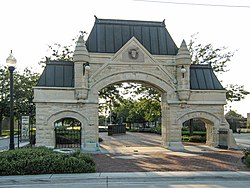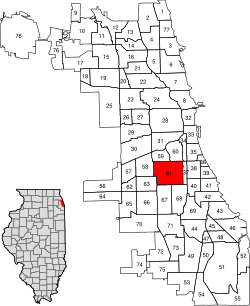New City, Chicago
New City
Back of the Yards/Canaryville | |
|---|---|
Community area | |
| Community Area 61—New City | |
 Union Stock Yard Gate at Exchange Ave. | |
 Location within the city of Chicago | |
| Coordinates: 41°48.6′N 87°39.6′W / 41.8100°N 87.6600°W | |
| Country | United States |
| State | Illinois |
| County | Cook |
| City | Chicago |
| Neighborhoods | List
|
| Area | |
| • Total | 4.86 sq mi (12.59 km2) |
| Population (2020) CDT) | |
| ZIP Code | part of 60609 |
| Median income 2020[1] | $35,396 |
| Source: U.S. Census, Record Information Services | |
New City is one of Chicago's 77
The area was home to the famous Union Stock Yards until it closed in 1971, and the International Amphitheatre until it was demolished in 1999.
Neighborhoods
| Census | Pop. | Note | %± |
|---|---|---|---|
| 1930 | 87,103 | — | |
| 1940 | 80,725 | −7.3% | |
| 1950 | 75,917 | −6.0% | |
| 1960 | 67,428 | −11.2% | |
| 1970 | 60,747 | −9.9% | |
| 1980 | 55,860 | −8.0% | |
| 1990 | 53,226 | −4.7% | |
| 2000 | 51,721 | −2.8% | |
| 2010 | 44,377 | −14.2% | |
| 2020 | 43,628 | −1.7% | |
| [1][2] | |||
Back of the Yards
Back of the Yards is an industrial and residential neighborhood so named because it was near the former
In 1939, the activist
Jane Jacobs, in her 1961 book The Death and Life of Great American Cities, cites the Back of the Yards as an area able to "unslum" in the 1960s, due to a beneficial set of circumstances. This included a stabilized community base with skilled members who were willing to trade work to upgrade housing, as well as active and well-led local social and political organizations. Jacobs often cited the Back of the Yards as a model for other depressed neighborhoods to follow to upgrade their communities.[5]
Some time after the 1970s, when the stockyard operations closed and the number of nearby jobs decreased, many people left to move to newer housing and work in the suburbs. The population of the neighborhood gradually reflected a new wave of settlement, predominantly
Canaryville
The Canaryville neighborhood is one of the oldest neighborhoods in Chicago, and borders the
Historically, Canaryville was a largely
Canaryville's name may refer to the sparrows who fed in the stockyards and railroad cars in the late 1800s. The name may also refer to white youth gangs in the neighborhood from the early 1900s, who were known as "wild canaries".[6]
Politics
The New City community area supported the Democratic Party in the 2012 and 2016 presidential elections. In 2016, New City cast 8,897 votes for Hillary Clinton and 1,331 votes for Donald Trump (84.40% to 12.63%).[7] In 2012, New City cast 9,053 votes for Barack Obama and 1,009 votes for Mitt Romney (89.36% to 9.96%).[8]
In the 2020 election, Canaryville largely voted for Donald Trump in contrast to its surrounding neighborhoods, with Trump having 820 votes compared to Joe Biden's 673.[9]
References
- ^ a b c d "Community Data Snapshot - New City" (PDF). cmap.illinois.gov. MetroPulse. Retrieved July 11, 2020.
- ^ Paral, Rob. "Chicago Community Areas Historical Data". Archived from the original on March 18, 2013. Retrieved September 3, 2012.
- ^ "Back of the Yards", Encyclopedia of Chicago
- ^ Sanford D. Horwitt: Let Them Call Me Rebel: Saul Alinsky. His Life and Legacy. Vintage Books, New York 1992, pp. 56–87.
- ^ Jacobs, Jane. The Death and Life of Great American Cities. New York: Random House, 1961.
- ^ a b "Canaryville", Encyclopedia of Chicago
- DNAInfo. Archived from the originalon September 24, 2019. Retrieved October 4, 2019.
- DNAInfo. Archived from the originalon February 3, 2019. Retrieved October 4, 2019.
- ISSN 0362-4331. Retrieved January 11, 2024.
External links
- Official City of Chicago New City Community Map
- Back of the Yards Neighborhood Council (oldest community organization in the United States, founded by Alinsky in 1939)
